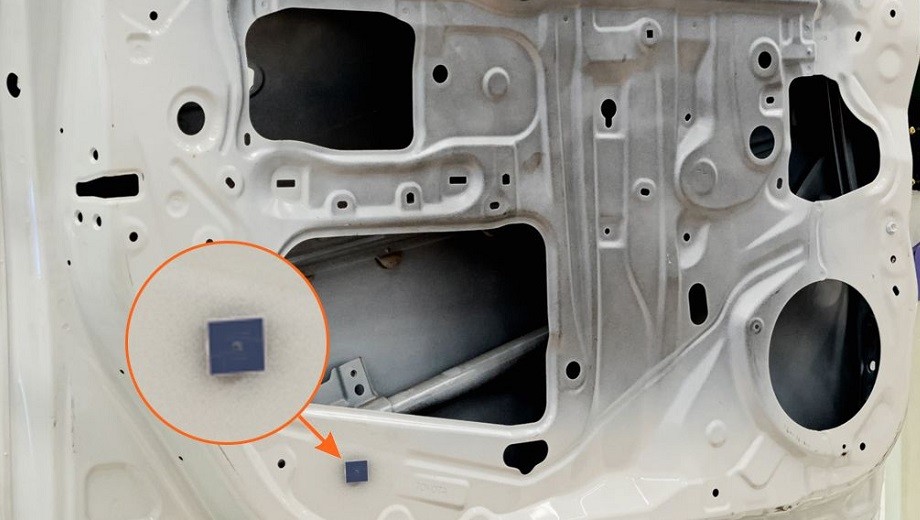U.K. logistics provider Paragon Automotive is using Smartrac's passive UHF RFID tags to track the receipt, finishing, storage and shipment of cars at its workshops and outdoor storage compound.
U.K. logistics provider Paragon Automotive is employing a radio frequency identification solution to track Kia vehicles near the Port of Immingham, on England's east coast, as vehicles are painted or otherwise modified, stored and then shipped to retail locations. The system consists of Paragon's own management software, a combination of mobile and fixed RFID readers, and an EPC Gen 2 passive ultrahigh-frequency (UHF) RFID tag attached to each vehicle so that the company can track its location. Using RFID enables Paragon to meet the high-volume, fast-paced requirements of an automotive market that has been growing in the United Kingdom.
Last year, Kia opened its new 35-hectare (86.5-acre) facility in Stallingborough for receiving vehicles manufactured abroad, finishing them and then shipping those cars to retail locations or fleets, such as rental agencies, in the United Kingdom. Paragon provides onsite storage and finishing services for those vehicles. The automotive service company installed its RFID system to boost visibility into the locations of cars, in order to increase its efficiency. Paragon serves auto manufacturers with refurbishment services for used cars, as well as finishing services for new vehicles. In the latter case, the company provides port operations, including preparing vehicles according to customer requirements, storing them in secure outdoor compounds and then releasing them for shipping. The firm services 750,000 used and new cars annually.
The market for new cars is growing, Paragon reports. According to the company, 2.63 million new vehicles were sold in the United Kingdom last year, setting a new record and signaling the fourth consecutive year in which the market has grown. The importing of these vehicles has put pressure on car manufacturers and their logistics suppliers to get the vehicles to retail locations in larger volumes and at a faster pace. Kia has approximately 20,000 new vehicles at its new port site at any given time, with an annual volume of 100,000.
Tracking the locations of all those cars manually is a time-consuming process, according to Chris Higgins, Paragon's group IT director. In fact, he says, a single inventory check of 20,000 vehicles would take a team of 20 employees an entire weekend to verify where each car is located. None of the new cars has a license plate fitted yet, making them difficult to identify visually.
In addition, operators need to be able to locate cars as they are moved through the finishing process, and that typically means considerable effort related to manually inputting locations into a system so that the information can later be used to find those vehicles. Each car is stored in a space identified by a particular row and bay. So an address could be, for instance, "Arrivals, row AA, bay 22." Every time an operator moves a vehicle, he or she uses a rugged Android-based handheld device to manually record the new location, along with the car's vehicle identification number (VIN).
"We definitely see RFID as a way of simplifying processes and making us more efficient," Higgins says. The technology is being used to corroborate the location data of a vehicle in storage—to determine, for instance, if a specific car is not parked in the zone, row and bay to which it was assigned. "Use of RFID means that we have a secondary method of locating any unit, in the event that the human operator did not record the location correctly." The company relies on data regarding zone, row and bay addresses that are manually inputted into Paragon's Evolution software, while the RFID system confirms that data. In addition, he says, RFID enables users in the workshop to identify a vehicle via a handheld reader, rather than having to enter the last eight digits of its VIN.
Paragon affixes a Smartrac DogBone tag to the interior of each vehicle's rear driver's-side window and links the tag's encoded ID number to the car's VIN.
Several years back, Paragon considered using active RFID tags at some of its sites because of the technology's inherent long read range, which could provide real-time location capability throughout the facility. However, Higgins says, applying an active tag to every vehicle would simply be too expensive to provide a return on investment. In February 2015, with the U.K. automotive industry booming, the company began investigating the use of passive UHF RFID tags. "We found ourselves again looking for better ways to control and monitor stock," he states.
The Kia site was in development at the time, and Paragon signed a 10-year contract for servicing the manufacturer's vehicles at that site, beginning in December 2015. This, Higgins says, made it a good location to launch the RFID system.
After the Kia vehicles are offloaded from a ship, Paragon affixes a Smartrac DogBone tag to the interior of the vehicle's rear driver's-side window, linking the tag's encoded ID number to the VIN. Operators then drive the cars into the Kia compound, where Paragon has installed about two dozen Zebra Technologies (Motorola Solutions) FX series readers throughout the site. RFID readers at the gate register each car's arrival by capturing its unique tag ID number, and forward the data to Kia's IT platform to inform the automaker that the vehicle is in stock. That information is then made available to dealers via Kia's IT platform, so they can order new cars.
Paragon designed the Evolution software to collect the RFID tag read data and forward it to Kia's IT platform and Paragon's management system, using software from Telerik for mobile and Web-based data display.
At the same time that the collected read data is sent to Kia, the Evolution software identifies the vehicle, determines the best location for it and displays that information on an automated message board, thereby instructing the driver where to deliver the car inside the outdoor storage compound. Readers mounted at key points, such as storage area entrances and choke points, enable the software to determine the general location at which a given vehicle is parked.
In addition, readers are located at the entrances to the workshop and pre-delivery inspection (PDI) areas. Thus, when a vehicle enters those areas, the system knows what finishing work is being provided, and that information is stored in the software to indicate when a car is ready to be shipped to a customer.
At each workstation, a video screen informs the technician which particular services—such as changing or removing upholstery, or adding a tow bar or decals—needs to be carried out, so that he or she can provide the service required, sign off on that work and have the vehicle delivered to the next assigned location. "The system provides our Evolution platform with a constant feed of all vehicles located by the fixed readers," Higgins says, "which we take as an 'overlay' to the existing process-driven locations and human inputs."
"This aids us in exception tracking," Higgins says—for example, if a vehicle leaves a workshop but a technician has not yet signed off on the PDI tasks in the software. In such a case, the software can display an alert so that workers onsite can redirect the car as needed, before a mistake can be made.
To pinpoint the locations of vehicles within storage bays, as well as provide additional inventory checks, Paragon mounted RFID readers to the roof of a pickup truck that is frequently used throughout the outdoor compound. As the pickup moves around the outdoor storage areas, the readers capture the tag IDs of any cars located to either side of the truck, and that data is linked to the truck's GPS location and forwarded to the Evolution software via a Wi-Fi connection.
"This provides us with a 'last seen' date, time and GPS location for each unit," Higgins explains, "which we also access within our IT platform." The company has integrated the data with online open-source mapping software supplied by Mapbox to provide accurate location information in a graphical form. The company has deployed a new feature this month using the GPS data to show, on a map, which areas the truck has covered.
Finally, when cars are loaded onto trucks to be transported to dealers, Paragon utilizes two sets of fixed readers at different heights to read the tags as the delivery trucks pass through the facility gates. This read data is also captured and stored in the software, where it is checked against the orders to ensure that no mistakes are being made, and to confirm shipment for historical purposes.
Employees at the workshop also carry handheld readers linked via Bluetooth to their rugged Android-based devices, in order to access vehicle IDs when needed. The system helps Paragon ensure that errors are not made during storage, finishing work, inspection or shipping, Higgins says, and also saves labor hours that employees would otherwise have to spend conducting manual inventory counts or walking through the facility searching for a specific vehicle.
Text and Photos by Claire Swedberg, courtesy of RFID Journal LLC



